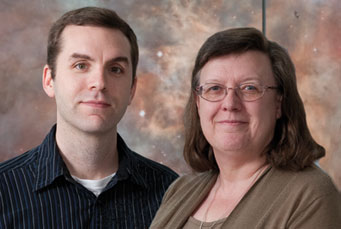
Thayne Currie and Carol Grady
Courtesy David Friedlander / NASA / GSFC
In the cover story of the August 2012 issue of Sky & Telescope, astronomers Thayne Currie and Carol Grady of NASA’s Goddard Space Flight Center discuss the fascinating young star LkCa 15. This system has been the subject of intense scrutiny over the past few years. Using some of the world’s leading telescopes, astronomers discovered that the star is surrounded by a disk, the first step in the formation of planets. Next, they discovered a large gap in the disk, the signature that one or more planets have already formed.
Recently, astronomers imaged an object inside the gap that appears to be a massive planet still in the process of formation. The planet’s distance from the star and its mass make it a close analog for the giant planets in our solar system. Thanks to these efforts, we might finally have a picture of a “baby solar system,” or more specifically, a system that resembles our own solar system when it was forming 4.6 billion years ago.
S&T Editor in Chief Robert Naeye recently interviewed Thayne and Carol. In this 13-minute discussion, they cover the properties of LkCa 15 and its candidate planet; how to determine the age and mass of distant objects; what LkCa 15 can teach us about solar-system formation; and what it's like to work on the frontiers of astronomy.
(If you don't see the player above, access the podcast here instead.) 0
0
Comments
You must be logged in to post a comment.